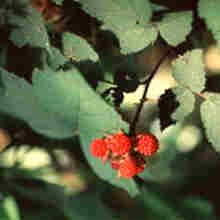
Plant Description
Caution & Interaction

Latin (botanical) name:
Rubus Idaeus
Common names: Red Raspberry, Raspbis, Hindberry, Bramble of Mount Ida, Bramblebush, Raspberry
Plant Description: Red Raspberry is believed to be indigenous to Europe and parts of Asia, but is also widely found in North America, Britain, Scandinavia, and Scotland. It grows naturally in woods and heaths and prefers temperate environments. Generally, Red Raspberry is grown for its delicious fruit. Red Raspberry is a deciduous bush with creeping perennial roots and erect, hairy or prickly, yellowish-green biennial stems. Its alternate pinnate leaves are shiny and green on top with a soft white feltlike underside. The leaves have three to seven serrate and ovate leaflets. Red Raspberry blooms around May to July with small, yellowish-white flowers located on auxiliary drooping racemes. The flowers have 5 petals, 5 sepals, and numerous stamen and ovaries. The fruit produced by the Red Raspberry is an aggregate that, when picked, separates from a conical receptacle leaving an empty shell. It is deep red and very sweet.
Medicinal Properties &Uses: Red Raspberry is a medicinal herb considered helpful in the treatment of frequent or excessive menstruation and other menstrual disorders. It is often used to ease labor and delivery, as well as to calm morning sickness and prevent miscarriage. Red Raspberry contains one of the highest number of volatile compounds of the more commonly eaten fruits. It contains benzaldehyde, ethyl acetate, limonene, and 2-phenylethanol, as well as a crystallizable fruit-sugar, a fragrant volatile oil, pectin, citric and malic acids, and mineral salts. It's leaves are high in tannins which gives it astringent qualities, niacin, manganese, and vitamin C. Due to the high manganese content, it is effective in glucose regulation. Red Raspberry is an effective treatment for diarrhea, nausea, colds, and flu. A decoction of Red Raspberry tea is used as a gargle for sore throats. It can also be used as a mouthwash for bleeding gums and cankers of the mouth. Red Raspberry is most well known for it's use during pregnancy to help alleviate the pain of labor and delivery. Due to its oxytocic properties, it can relax and tone uterine muscles. For thousands of years, midwives and Chinese herbalists have used Red Raspberry effectively. It has also demonstrated antigonadotropic activity, and may normalize blood sugar levels. Red Raspberry is thought to be antioxidant, anti-inflammatory, anti-diarrheal, daiphoretic, diuretic, antiseptic, and choleretic.
Dosage: 30-90 drops in water or juice, 2-3 times daily or as needed. Shake well before using.
Cautions & Interactions: Keep out of reach of children.
Efficacy Studies & Other Clinical Data: Helpful Links:
Disclaimer (U.S. Only): These statements have not been evaluated by the FDA. These products are not intended to diagnose, cure, treat, or prevent any disease.
Common names: Red Raspberry, Raspbis, Hindberry, Bramble of Mount Ida, Bramblebush, Raspberry
Plant Description: Red Raspberry is believed to be indigenous to Europe and parts of Asia, but is also widely found in North America, Britain, Scandinavia, and Scotland. It grows naturally in woods and heaths and prefers temperate environments. Generally, Red Raspberry is grown for its delicious fruit. Red Raspberry is a deciduous bush with creeping perennial roots and erect, hairy or prickly, yellowish-green biennial stems. Its alternate pinnate leaves are shiny and green on top with a soft white feltlike underside. The leaves have three to seven serrate and ovate leaflets. Red Raspberry blooms around May to July with small, yellowish-white flowers located on auxiliary drooping racemes. The flowers have 5 petals, 5 sepals, and numerous stamen and ovaries. The fruit produced by the Red Raspberry is an aggregate that, when picked, separates from a conical receptacle leaving an empty shell. It is deep red and very sweet.
Medicinal Properties &Uses: Red Raspberry is a medicinal herb considered helpful in the treatment of frequent or excessive menstruation and other menstrual disorders. It is often used to ease labor and delivery, as well as to calm morning sickness and prevent miscarriage. Red Raspberry contains one of the highest number of volatile compounds of the more commonly eaten fruits. It contains benzaldehyde, ethyl acetate, limonene, and 2-phenylethanol, as well as a crystallizable fruit-sugar, a fragrant volatile oil, pectin, citric and malic acids, and mineral salts. It's leaves are high in tannins which gives it astringent qualities, niacin, manganese, and vitamin C. Due to the high manganese content, it is effective in glucose regulation. Red Raspberry is an effective treatment for diarrhea, nausea, colds, and flu. A decoction of Red Raspberry tea is used as a gargle for sore throats. It can also be used as a mouthwash for bleeding gums and cankers of the mouth. Red Raspberry is most well known for it's use during pregnancy to help alleviate the pain of labor and delivery. Due to its oxytocic properties, it can relax and tone uterine muscles. For thousands of years, midwives and Chinese herbalists have used Red Raspberry effectively. It has also demonstrated antigonadotropic activity, and may normalize blood sugar levels. Red Raspberry is thought to be antioxidant, anti-inflammatory, anti-diarrheal, daiphoretic, diuretic, antiseptic, and choleretic.
Dosage: 30-90 drops in water or juice, 2-3 times daily or as needed. Shake well before using.
Cautions & Interactions: Keep out of reach of children.
Efficacy Studies & Other Clinical Data: Helpful Links:
Disclaimer (U.S. Only): These statements have not been evaluated by the FDA. These products are not intended to diagnose, cure, treat, or prevent any disease.